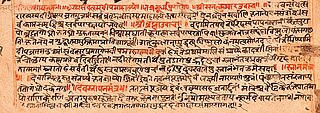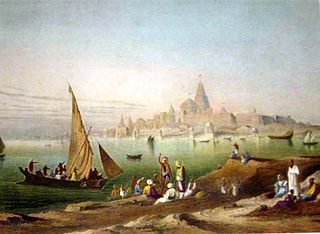Hinduism is an umbrella term for a range of Indian religious and spiritual traditions (sampradayas) that are unified by adherence to the concept of dharma, a cosmic order maintained by its followers through rituals and righteous living, as first expounded in the Vedas. The word Hindu is an exonym, and while Hinduism has been called the oldest religion in the world, it has also been described by the modern term Sanātana Dharma emphasizing its eternal nature. Another endonym for Hinduism is Vaidika Dharma.

Parashurama, also referred to as Rama Jamadagnya, Rama Bhargava and Virarama, is the sixth avatar among the Dashavatara of the preserver god Vishnu in Hinduism. He is destroyer of the evil on this planet. Shiva advised him to go and liberate the Mother Earth from felons, ill-behaved people, extremists, demons and those blind with pride. He is one of the Chiranjivis (Immortals), who will appear at the end of the Kali Yuga to be the guru of Vishnu's tenth and last incarnation, Kalki.

Mahamaham, also known as Mahamagham or Mamangam, is a Hindu festival celebrated every 12 years in the Mahamaham tank located in the city of Kumbakonam in Tamil Nadu in the south of India. This 20-acre square tank surrounded by Shiva mandapams is believed by Tamil Hindus to be ancient, and the holy confluence of nine Indian river goddesses: Ganga, Yamuna, Sarasvati, Narmada, Godavari, Krishna, Tungabhadra, Kaveri, and Sarayu, states Diana Eck – a professor of Comparative Religion and Indian Studies. On the day of the Mahamaham festival, the river goddesses and Shiva gather here to rejuvenate their waters, according to a legend in the Periya Purana. The Hindus consider taking a pilgrimage and holy dip at the Mahamaham tirtha on the day of Mahamaham festival as sacred. The event attracts chariot processions, street fairs and classical dance performances in temple mandapas. The 12-year cycle Mahamaham festival in Tamil Nadu is observed in the Hindu calendar month of Magha, and is a symbolic equivalent of the Kumbh Mela.

Puranas (Ancients), are a vast genre of Hindu literature about a wide range of topics, particularly about legends and other traditional lore. The Puranas are known for the intricate layers of symbolism depicted within their stories. Composed originally in Sanskrit and in other Indian languages, several of these texts are named after major Hindu gods such as Vishnu, Shiva, Brahma, and Tridevi. The Puranic genre of literature is found in both Hinduism and Jainism.

Kumbh Mela or Kumbha Mela is a major pilgrimage and festival in Hinduism. On 4 February 2019, Kumbh Mela witnessed the largest peaceful public gathering of humans ever recorded. It is celebrated in a cycle of approximately 12 years, to celebrate every revolution Brihaspati (Jupiter) completes. Kumbh is mainly held at four riverside pilgrimage sites, namely: Prayagraj, Haridwar (Ganges), Nashik (Godavari), and Ujjain (Shipra); But now the Kumbh Mela has been revived at a fifth place too. The other rejuvenated Kumbh Mela is celebrated at Bansberia Tribeni Sangam in West Bengal at the confluence of Hooghly and Saraswati river, dates back thousands of years but was stopped 700 years ago, but this Kumbh Mela has been reopened since 2022.

Trimbakeshwar Shiva Temple is an ancient Hindu temple in the town of Trimbak, in the Trimbakeshwar tehsil in the Nashik District of Maharashtra, India, 28 km from the city of Nashik and 40 km from Nashik road. It is dedicated to the Hindu god Shiva and is one of the twelve jyotirlingas where the Hindu genealogy registers at Trimbakeshwar, Maharashtra are kept. The origin of the sacred Godavari River is near Trimbak.

Somnath temple or Deo Patan, is a Hindu temple, located in Prabhas Patan, Veraval in Gujarat, India. It is one of the most sacred pilgrimage sites the Tirtha Kshetra for Hindus and is the first among the twelve jyotirlinga shrines of Shiva. It is unclear when the first version of the Somnath temple was built, with estimates varying between the early centuries of the 1st millennium and about the 9th century CE. Various texts, including the Mahabharata and Bhagavata Purana, mention a tirtha at Prabhas Patan on the coastline of Saurashtra, where the later temple was, but archaeology has not found traces of an early temple, though there was a settlement there.
Vrata is a Sanskrit word that means "vow, resolve, devotion", and refers to pious observances such as fasting and pilgrimage (Tirtha) found in Indian religions such as Hinduism and Jainism. It is typically accompanied with prayers seeking health and happiness for their loved ones.
Kshetram (Kshetra) literally means a region. In Hindu mythology, it is referred to as the physical holy location where a temple or a collection of temples, its tank and deities exist.

The 'Bhavishya Purana' is one of the eighteen major works in the Purana genre of Hinduism, written in Sanskrit. The title Bhavishya means "future" and implies it is a work that contains prophecies regarding the future.

The Kurma Purana is one of the eighteen Mahapuranas, and a medieval era Vaishnavism text of Hinduism. The text is named after the tortoise avatar of Vishnu.

The Skanda Purana is the largest Mukhyapurāṇa, a genre of eighteen Hindu religious texts. The text contains over 81,000 verses, and is of Shaivite literature, titled after Skanda, a son of Shiva and Parvati. While the text is named after Skanda, he does not feature either more or less prominently in this text than in other Shiva-related Puranas. The text has been an important historical record and influence on the Hindu traditions and rituals related to the war-god Skanda.

The Linga Purana is one of the eighteen Mahapuranas, and a Shaivism text of Hinduism. The text's title Linga refers to the iconographical symbol for Shiva.

Dvārakā, also known as Dvāravatī, is a sacred historic city in the sacred literature of Hinduism, Jainism, and Buddhism. It is also alternatively spelled as Dvarika. The name Dvaraka is said to have been given to the place by Krishna, a major deity in Hinduism. Dvaraka is one of the Sapta Puri of Hinduism.

The Ramanathaswamy Temple is a Hindu temple dedicated to the Hindu god Shiva located on Rameswaram island in the state of Tamil Nadu, India. It is one of the twelve Jyotirlinga temples. It is one of the 275 Paadal Petra Sthalams, the sacred sites glorified by the Nayanars, Appar, Sundarar, and Sambandar, with their songs. According to tradition, the lingam of the Ramanathaswamy Temple was established and worshipped by Lord Ram before he crossed the bridge called Rama Setu to the island kingdom of Lanka, identified with Sri Lanka. It is one of the Char Dham pilgrimage sites. The temple was expanded during the 12th century by the Pandya Dynasty, and its principal shrine’s sanctum was renovated by Jeyaveera Cinkaiariyan and his successor Gunaveera Cinkaiariyan, monarchs of the Jaffna kingdom. The temple has the longest corridor among all the Hindu temples of India. It was built by King Muthuramalinga Sethupathy. The temple is considered a pilgrimage site for Shaivites, Vaishnavites, and Smartas.

In Hinduism, the yatra (pilgrimage) to the tirthas has special significance for earning the punya needed to attain the moksha (salvation) by performing the darśana, the parikrama (circumambulation), the yajna, the Dhyana, the puja (worship), the prarthana, the dakshina, the seva, the bhandara, etc. These sacred places are usually located on the banks of sacred waters, such as sacred rivers or their tributaries, the kundas, the ghats, or the stepwells, or the temple tanks.

Yatra, in Indian-origin religions, Hinduism, Buddhism, Jainism and Sikhism, generally means a pilgrimage to holy places such as confluences of sacred rivers, sacred mountains, places associated with Hindu epics such as the Mahabharata and Ramayana, and other sacred pilgrimage sites. Visiting a sacred place is believed by the pilgrim to purify the self and bring one closer to the divine. The journey itself is as important as the destination, and the hardships of travel serve as an act of devotion in themselves.
Prāyaścitta is the Sanskrit word which means "atonement, penance, expiation". In Hinduism, it is a dharma-related term and refers to voluntarily accepting one's errors and misdeeds, confession, repentance, means of penance and expiation to undo or reduce the karmic consequences. It includes atonement for intentional and unintentional misdeeds. The ancient Hindu literature on repentance, expiation and atonement is extensive, with earliest mentions found in the Vedic literature. Illustrative means to repent for intentional and unintentional misdeeds include admitting one's misdeeds, austerities, fasting, pilgrimage and bathing in sacred waters, ascetic lifestyle, yajna, praying, yoga, giving gifts to the poor and needy, and others.

Magh mela, also spelled Magha mela, is an annual festival with fairs held in the month of Magha (January/February) near river banks and sacred tanks near Hindu temples. About every twelve years, Magha melas coincide with what is believed by faithful as an astrologically auspicious position of Jupiter, sun and moon, and these are called the Kumbh Mela such as the one at Allahabad. In the south, a notable festival is at the Mahamaham tank in Kumbhakonam; in the east, at Sagar island of West Bengal and Konark, Puri. The Magha festival, along with the bathing rituals as a form of penance, is also observed by the Hindu community in Bali, Indonesia.

The Matsya Purana is one of the eighteen major Puranas (Mahapurana), and among the oldest and better preserved in the Puranic genre of Sanskrit literature in Hinduism. The text is a Vaishnavism text named after the half-human and half-fish avatar of Vishnu. However, the text has been called by the 19th-century Sanskrit scholar Horace Hayman Wilson, "although a Shaivism (Shiva-related) work, it is not exclusively so"; the text has also been referred to one that simultaneously praises various Hindu gods and goddesses.


















